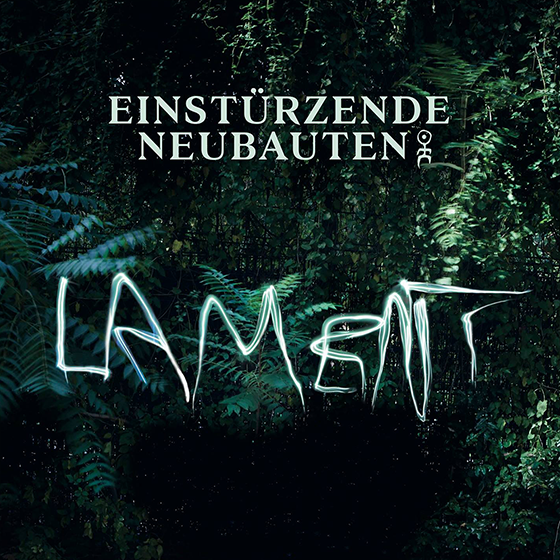Einstürzende Neubauten, "Lament"
 This month, Germany marks two anniversaries of note. The 100th anniversary of the start of the first World War represents one of the darker moments of their history whereas the 25th anniversary of the fall of the Berlin Wall represents a beacon of hope. Einstürzende Neubauten were there for the latter and channel the energy that ran through the divided city of Berlin even still. Through this new project, they connect the dots between the conflicts of today and those of the past while marking the passing of all those who have fallen under the relentless combat and struggle that has plagued mankind since its beginning.
This month, Germany marks two anniversaries of note. The 100th anniversary of the start of the first World War represents one of the darker moments of their history whereas the 25th anniversary of the fall of the Berlin Wall represents a beacon of hope. Einstürzende Neubauten were there for the latter and channel the energy that ran through the divided city of Berlin even still. Through this new project, they connect the dots between the conflicts of today and those of the past while marking the passing of all those who have fallen under the relentless combat and struggle that has plagued mankind since its beginning.
For decades, the majority of art surrounding the first World War centered around the horror and tragedy of the trenches. Poets like Siegfried Sassoon and Wilfred Owen relayed the realities of the front line in verse and novels like Erich Remarque’s All Quiet on the Western Front and Sebastian Faulks’s Birdsong provided chilling insights (either first hand or historical) into the psychology of soldiers on both sides; their fears, hopes and indifference made word. In music, one only has to look at Benjamin Britten’s War Requiem for a haunting elegy to all wars and all the loss contained therein. Yet, in recent years, alternative takes on the first World War have permeated the arts with the Sébastien Japrisot’s Un long dimanche de fiançailles (and Jean-Pierre Jeunet’s film adaptation) showing a more light-hearted and hopeful side to the aftermath of the Great War or Will Self’s fabulous and head-melting Umbrella, a fusion of artillery production, neuropharmacology and modernism.
It is towards Self‚Äôs end of interpretation that Einstürzende Neubauten have taken for their commissioned work Lament. Created for a site-specific performance at the Belgian city of Diksmuide, a city reduced to rubble over the course of heavy fighting during the war. Diksmuide remained a front line for four years, with the Germans and Belgian-French armies locked in a seemingly endless grind of casualties. To give an estimation of its bloodiness, the main trench just outside the city was known as the "Trench of Death" in a war that was meant to end all wars. Blixa Bargeld takes this well-worn phrase and uses it as a springboard for his own historical and artistic investigations. Bargeld maintains that wars never end, war instead just moves and constantly shifts to new locations and conditions. Indeed, it is obvious from perusing the history books that almost all conflicts are intimately related to others, from the large scale of the two World Wars to smaller threads running from civil wars to border disputes. For the instrumental "Kriegsmaschinerie" that opens Lament, Bargeld remains quiet and instead written passages are to be read at certain times during the piece. For the live performances, he holds up large cards with the lines written on them but on the recording we have to make do with the words being printed in the liner notes. Here, Bargeld insists that "War does not break out, and it is never caught or chained; it moves" while a clanging dirge comes as if from the bowels of the earth, bringing to mind classic Neubauten pieces like "Das Schaben" and "Armenia" (indeed "Armenia" being one of a handful of old songs played during the live performances of Lament).
The absurdity of war as being discrete political entities is explored in "Hymnen" and "The Nicky-Willy Telegrams." In the former, the familiar tune of "God Save the King" is played with Neubauten singing a chimera of the various national anthems of the United Kingdom, Canada and Germany – highlighting the common ancestry and living links between these countries at war with each other. On the latter, Bargeld and Alexander Hacke sing the correspondence between Kaisar Wilhelm and Tsar Nicholas, the respective leaders of Germany and Russia along with being first cousins with each other and King George of England. The conversation is sung with a bizarre autotune effect, reflecting the falseness of the sentiments contained in the telegrams (on the face of it, they claim to be looking for ways to avoid war but all the while were moving their armies into position). Between these two pieces, Neubauten show that not only does war never sleep, it does not care if both sides are really same side underneath it all.
Throughout Lament, there is a strong sense of theatre and, as with Neubauten’s theatre work during the nineties, bespoke instrumentation was built by the band to create a visual and metaphorical link between the abstract sounds and the themes. On "In Der Loopgraaf," NU Unruh uses a harp made from barbed wire as a dulcimer-like percussive instrument to accompany Paul van den Broeck’s poem about his inability to dance in the trenches and the looming weight of knowing that the open earth is one long grave for all the men stationed there. Elsewhere, Morse code and amplified crutches are employed and spent artillery shells are used as perscussion instruments. Judging from the photos in the booklet, there is even a replica of one of Luigi Russolo’s intonarumori which was created with replicating the noise of contemporary life in the 1910s (not forgetting that war was one of the chief fascinations of the Italian Futurists, with Russolo serving as a motorcyclist in the Italian army).
The plastic piping used with great effect on Perpetuum Mobile on the "statistical piece of music" "Der 1. Weltkrieg" where the time line of the war is mapped out in music with each country assigned a different pipe (all of different lengths to differentiate them by sound) and each day of the conflict counted by each beat in the song. The days that each country fought are played, resulting in a complex piece which elegantly represents the bare facts about the war: who fought when and for how long. The idea of this being statistical music stretches out into the rest of the album with Neubauten hiring an actual historian to help them research the untold stories and fine details often glossed over in coverage of the war (both historical and artistic). Bargeld has stated in interviews that he wanted to avoid the obvious stories and clichéd sources that are so often used by other artists, by working with a real historian Neubauten have certainly created something unique.
Yet, it would be unfair to think that Neubauten were avoiding the humanity and the emotional weight that goes hand in hand with the topic. The album’s centrepiece is a three movement piece which shares the album’s title. "Lament 1. Lament" is an almost abstract vocal work where the band slowly layer their voices over each other, building a river of sound from which Bargeld launches accusations of the mutual lies and love of power making war (my rough translation!). An instrumental middle movement based on the numbers making up "1918" gives way to the heart-wrenching "Lament 3. Pater Peccavi." Much like Gavin Bryar’s The Sinking of the Titanic, Neubauten combine unbelievably sad music (based on a 16th century motet written by Diksmuide’s own Jacobus Clemens non Papa) with wax cylinder recordings of a linguistics project being performed on prisoners of war. The researchers were interested in the many dialects and languages that existed in Europe at the time, asking them to recite the story of the Prodigal Son in their own language. Here the casualty of culture is laid bare, from the end of the war Europe would become better connected and homogenised with various lingua franca taking hold in each state, erasing dozens of languages from history.
It might be odd to think of a Cold War-era band from Germany being asked to mark the centenary of World War I in Belgium but when you consider Neubauten’s inspirations and the lineage of experimental art in the 20th century, it all stems from the first world war. Walter Benjamin’s art theories required the development of the kind of machinery that lead to wholesale slaughter and the bloody birth of Dada in the middle of the war; both essential forerunners to Neubauten. This runs almost in parallel with Bargeld’s thesis on war never sleeping but moving from place to place; equally the creative arts can be seemingly obliterated or vanish from somewhere, only to pop up in other places and other times when least expected.
 



